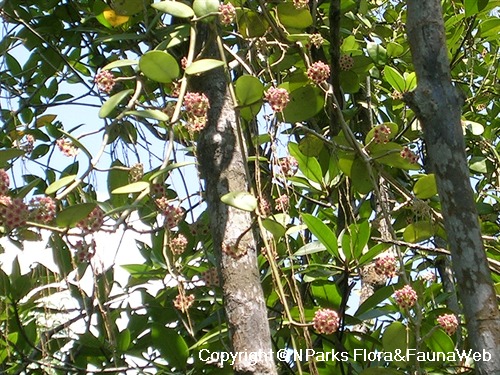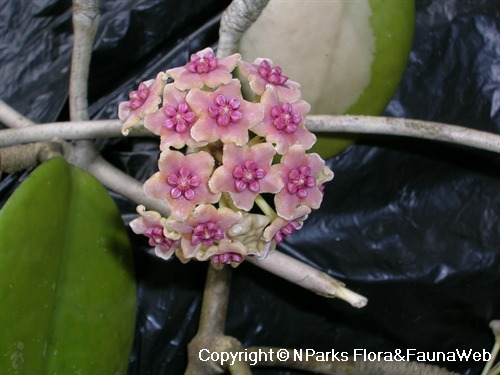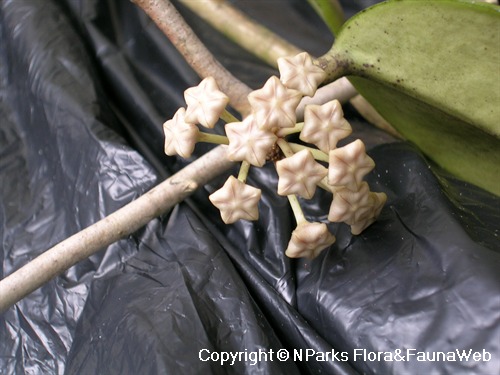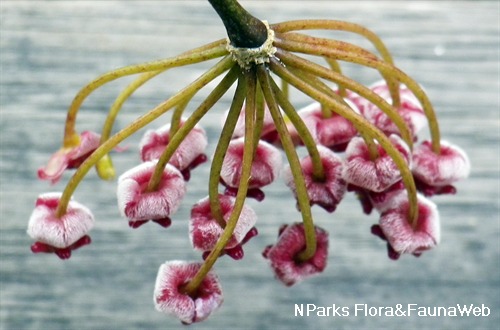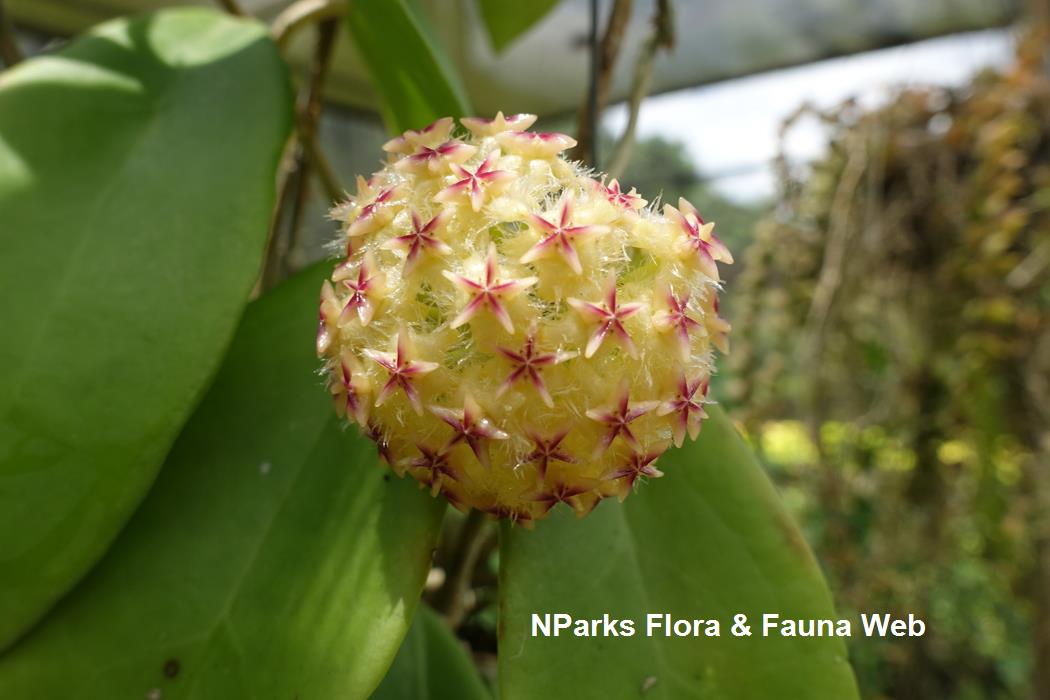
Back
Hoya diversifolia Blume
| Family Name: | Apocynaceae |
| Common Name: | Akar Kekapal, Akar Serapat, Akar Sesapat, Akar Sedudu Bukit, Caping Kera, 异叶球兰 |
Name
Classifications and Characteristics
| Plant Division | Angiosperms (Flowering Seed Plants) (Dicotyledon) |
|---|---|
| Plant Growth Form | Climber, Epiphyte |
| Lifespan (in Singapore) | Perennial |
| Mode of Nutrition | Autotrophic |
Biogeography
| Native Distribution | Myanmar, Vietnam, Thailand, Cambodia, Sumatra, Peninsular Malaysia, Singapore, Borneo, Java, and the Philippines |
|---|---|
| Native Habitat | Terrestrial (Coastal Forest), Shoreline (Mangrove Forest) |
| Preferred Climate Zone | Tropical |
| Local Conservation Status | Native to Singapore (Vulnerable (VU)) |
Description and Ethnobotany
| Growth Form | Epiphytic climber, often forming a dense covering on trees branches on which they grow. |
|---|---|
| Foliage | Its stalked leaves have very thick, and fleshy leaf blades that are elliptic-obovate, and are up to 13 by 6.4 cm. |
| Flowers | 1–20 flowers develop in umbrella-shaped flowering clusters (inflorescence), star-shaped, cream or pink with pink centers, and are 0.8–1.3 cm wide. |
| Fruit | Its fruits are follicles that would split open at one side when mature, and are up to 15 by 0.6 cm. |
| Habitat | This species is tolerant of a wide range of habitats and can be found growing on mangrove or coastal trees. In Malaysia, this species can also be found growing on oil palm. |
| Associated Fauna | Its flowers are insect-pollinated. |
| Cultivation | It can be propagated by seed or stem cutting. |
| Etymology | Latin Hoya, commemorates Thomas Hoy, a 18th century head gardener to the Duke of Northumberland at Syon House, Isleworth; Latin diversifolia, variable-leaved |
| Ethnobotanical Uses | Others: Plant is used in Malay folk medicine (Kuala Kangsar, Peninsular Malaysia) - leaves are boiled in water and the decoction is used for hot baths to treat fevers and rheumatism. |
Landscaping Features
| Landscaping | It is suitable for growing in parks, gardens and streetscapes, on trees or on trellises and pergolas. |
|---|---|
| Desirable Plant Features | Ornamental Flowers, Fragrant |
| Landscape Uses | Suitable for Hanging Baskets, Interiorscape/ Indoor Plant, General, Parks & Gardens, Small Gardens, Coastal, Beachfront / Shoreline, Vertical Greenery / Green Wall, Trellis / Arbour / Pergola |
Fauna, Pollination and Dispersal
| Pollination Method(s) | Biotic (Fauna) |
|---|---|
| Seed or Spore Dispersal | Abiotic |
Plant Care and Propagation
| Light Preference | Semi-Shade |
|---|---|
| Water Preference | Little Water, Moderate Water, Occasional Misting |
| Plant Growth Rate | Fast to Moderate |
| Rootzone Tolerance | Moist Soils, Well-Drained Soils, Saline Soils / Salt Spray, Fertile Loamy Soils, Easy to Grow |
| Propagation Method | Seed, Stem Cutting |
Foliar
| Foliage Retention | Evergreen |
|---|---|
| Mature Foliage Colour(s) | Green |
| Mature Foliage Texture(s) | Leathery, Thick |
| Foliar Type | Simple / Unifoliate |
| Foliar Arrangement Along Stem | Opposite |
| Foliar Attachment to Stem | Petiolate |
| Foliar Shape(s) | Non-Palm Foliage (Obovate, Elliptical) |
| Foliar Margin | Entire |
Floral (Angiosperm)
| Flower & Plant Sexuality | Bisexual Flowers |
| Flower Colour(s) | Pink |
|---|---|
| Flower Texture(s) | Velvety / Furry / Tomentose |
| Flower Grouping | Cluster / Inflorescence |
| Flower Location | Axillary |
| Flower Symmetry | Radial |
| Flowering Opening Time | Time-Independent |
| Flower Lifespan on Plant | Several Days |
Fruit, Seed and Spore
| Mature Fruit Colour(s) | Brown |
|---|---|
| Fruit Classification | Simple Fruit |
| Fruit Type | Dehiscent Dry Fruit , Follicle |
Image Repository
Others
| Master ID | 117 |
|---|---|
| Species ID | 1413 |
| Flora Disclaimer | The information in this website has been compiled from reliable sources, such as reference works on medicinal plants. It is not a substitute for medical advice or treatment and NParks does not purport to provide any medical advice. Readers should always consult his/her physician before using or consuming a plant for medicinal purposes. |

